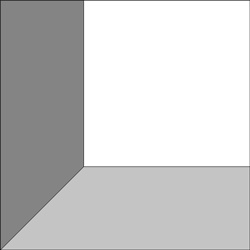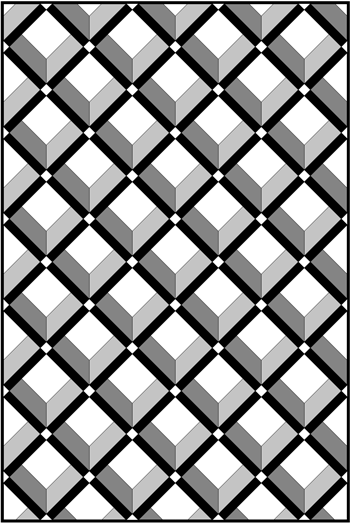This post contains affiliate links for which I receive compensation
Adding stabilizer to the entire back of a quilt
by Nicole
(Estacada, OR)
Nicole writes...
I have a quilt that is a window pane pattern. The panes and windows run on a 45 angle.Because the windows I started cutting the windows so that they will have the the lengthwise grain running at a 45 degree angle and don't have enough fabric to change it so the length wise grain will run top to bottom. Also because I wanted to use a particular pattern on the sash material the small panes of course have the lengthwise grain running the same direction as the windows. The long panes are cut on the same lengthwise grain at a 45 degree angle.
I was having a lot of trouble with stretch in my quilt and couldn't get the windows and small panes to line up as they are supposed to between each row.
I would like to know if I can put stabilizer on the back of the quilt to help protect the quilt from stretch and still do a stitch in the ditch along the window panes?
Julie replies...
Good Morning, Nicole!I'm a little fuzzy on the description of your quilt, so I'm going to restate it and hope that you can determine if we're talking about the same thing.
First, by window pane quilt, I believe you're talking about a block like this...

...and that the blocks are set on-point something like this...

...that way you'd end up with the bias grain running from North to South in your quilt. All the seams between the blocks and sashing (i.e. the edges that are stitched together) are on the straight of grain.
If this is close to your situation, then I'd proceed as follows.
Using a stabilizer for the whole quilt top
I have to admit that I'm not a fan of this solution. If it was a small wall hanging, then maybe, because it's size would make it more manageable.The problem that I envision is actually getting the stabilizer attached evenly and without further stretching the blocks. An iron-on stabilizer needs to be pressed on—iron set in one place for a certain number of seconds, then the next place, then the next—hugely time consuming, and you'll need an extra large space to press to keep the weight of the top from pulling things.
You could spray baste a stabilizer (but again you'd need a large space to work in and I can envision needing to pull the top away from the stabilizer to get everything straight. That seems like too much extra wear-and-tear on the top. (Click here to learn more about spray basting a quilt sandwich.)
Stabilizing the individual blocks
If the blocks themselves haven't been pieced together, then it would be possible to use an iron-on stabilizer on the back of them. I'd want to have a really, really good press job on the blocks before adding the stabilizer. Once it's on, it's not coming off. Twisted seam allowances should be fixed, stray threads clipped and any dark seam allowances that might show through to the top should be trimmed back to a bit short of a full 1/4".It'd be much easier to 'press' the stabilizer to a single block (remember pressing is an up and down movement).
Backing Fabric Grainline
If your quilt resembles the one I showed above, then the whole quilt is on the bias from North to South. I strongly recommend that you use a backing fabric cut so that the lengthwise (strongest and most stable) grainline runs from North to South, too. That will help to stabilize the quilt.Sometimes quilters will create a backing where the seam lines (and lengthwise grain) runs East to West to save fabric. Don't do that for this quilt, especially if it will hang on the wall. Let the least stretchy grainline do some of the work for you.
Batting can have a grainline
Yep! I was surprised by this, too!Give your chosen batting a gentle pull in both the lengthwise and crosswise directions. Sometimes there is a noticeable difference in the amount of stretch.
Cut the one with the least amount so that it's stable grain runs from North to South, too. Every little bit helps.
Sashing
For a design with sashing between the rows like the one above, if you're having trouble getting all your blocks lined up, grab a chalk pencil.On the back side of the sashing use your ruler to mark where the edges of the blocks should be. Mark from the back because that's what you'll see as you pin things together in preparation for stitching.
Personally, I'd go to the extra effort of adding a cornerstone (pictured in white so that you can see it above), because then there'll be a seam line to match instead of all that marking.
In the long run, that would be faster for me, however you should be mindful of what works best for YOU.
Ditch Quilting
Since all the ditch quilting will be on the diagonal, I would pin baste the living daylights out of it. Avoid the seamlines because that's where you'll stitch first. That way you don't need to remove a bunch of pins to get them out of the way—avoid the excessive starting and stopping.The very instant you see any type of 'poofiness' building in front of your walking foot, stop IMMEDIATELY. With the needle down through the quilt sandwich, lift the presser foot and put it back down again. Continue stitching. This should help you avoid stitching tucks into the top.
You can always go in and add extra straight pins to help tame the sandwich as you're stitching (they're easier to remove).
To further stabilize the sandwich, you could add a couple of lines of quilting straight down through the quilt and crosswise through it with a water soluble thread. You've just got to make sure that the water temperature for removing this type of thread and water temperature needed to remove any markings from the quilt are compatible.
Click here for more information on how to machine quilt a diagonal set.
I hope some of these suggestions are helpful to you. If I've completely misunderstood, please let me know and I'll try again!
Piecefully,
Julie Baird
Editor
Comments for Adding stabilizer to the entire back of a quilt
|
||
|
||















